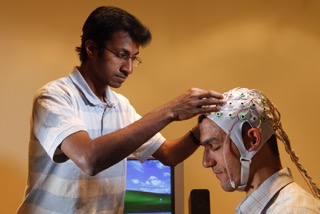Electro-encephalography (EEG) Suite
Electroencephalography (EEG) records the electrical activity naturally produced by the brain, as the coordinated activity of neurons creates electric currents large enough to be measured at the scalp’s surface. This activity echoes the ongoing processes that stem from the brain performing even the simplest tasks, like perceiving a picture, making a decision, or moving a limb. In clinical contexts, EEG is heavily used to monitor the normal activity of the brain, as well as the activity that may reflect signs of disorders, such as epilepsy. Researchers use this technique to measure the sequence of processes that give rise to particular cognitive abilities, such as orienting one’s attention to objects in the environment.
EG is a safe and convenient way to measure brain activity for research and clinical purposes as it is non-invasive and relatively simple to set-up. Therefore, EEG is used on a wide variety of populations, from babies to the elderly.
Researchers at CINN are use this technique to study visual perception, emotions, as well as our ability to understand language. We also use EEG to inform the design of the next generation of brain-computer interfaces, which will allow us to control our environment with our thoughts.
Our EEG Lab at CINN is housed in a fully-RF shielded room, to prevent the EEG signal from being confounded with external noise. We maintain a longstanding relationship with established neurophysiological research equipment provider Brain Products GmbH, of which we possess EEG Caps ranging from 32 through to 128 channels, as well as TMS and EEG compatible caps for multimodal imaging.




